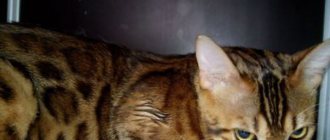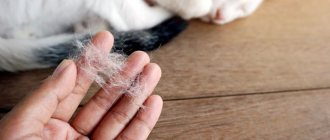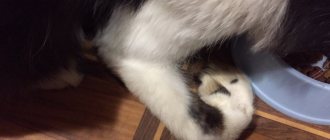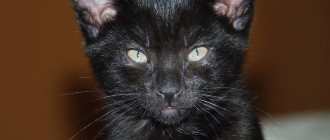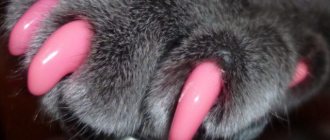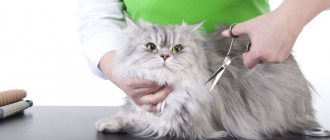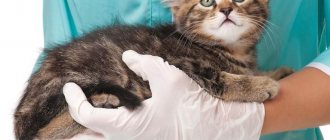About 15% of cat injuries occur due to falls from a height.
More often this trouble happens to them at night. It turns out that the safest floors for cats to fall from in residential buildings are the fifth to ninth floors. When falling from low floors, the animal does not have time to group itself correctly, and when falling from a higher height, grouping will not help. Even a fall from the kitchen table can be traumatic for small kittens, since control of their body comes to them in full with age. If a cat falls into obstruction in the form of clotheslines or tree branches, the injuries may be more serious than from a simple fall.
If a cat falls, it can suffer varying degrees of injury. It may be limited to ordinary fright, but it can also break its legs, get a head or spine injury, or severe bruise of internal organs. If the cat is not very old and seeks veterinary help after an injury, almost any injury can be treated. Measures must be taken to prevent accidental falls of the animal. It is better to keep the windows closed, or be sure to install a net.
If a fall could not be avoided, first aid must be provided. A frightened animal may simply hide somewhere to lie down in a secluded place. We definitely need to find it and inspect it. In such a situation, the cat can behave very aggressively, so gloves will not hurt you to protect yourself from claws and teeth.
Cats are very patient and hardy. It is very difficult to determine by appearance whether an animal is in pain or not after a fall. It happens that after a fall, a cat quickly jumps up and runs away without external signs of damage. Although some time after this misfortune she may die from internal bleeding. Therefore, after any serious fall, you should definitely contact a veterinarian for help. If after a fall the cat continues to lie at the site of the fall, then you need to act very quickly and carefully. The best option is to carefully place the victim on a hard surface, such as a sheet of plywood, and take her to the nearest hospital.
Most often, animals that fall from a height die not from their injuries, but from shock!
What are the symptoms of serious injury after a fall?
A cat falling from a height of the 6th floor is considered more dangerous than, for example, from the 7th. The animal simply does not have time to group itself in the process and land normally. Falling from the ninth floor and above is dangerous because a fairly high speed develops, and the impact on the ground becomes stronger.
Cats love to sit on the windowsill and watch the world around them.
If an accident occurs, you need to find the animal as quickly as possible. Often owners, without noticing obvious signs, calm down and do not go to the veterinarian. However, even if the cat does not clearly show its poor condition, you should carefully monitor the animal’s behavior and pay attention to all the slightest changes.
Fractures and bruises
Most often, cats that fall from a height have bruises and fractures. Such phenomena are characterized by the following symptoms:
- With severe bruises, hematomas may appear at the site of injury; the cat does not allow the sore spot to be touched.
- Fractures are more difficult to detect - they can be open or closed. When open, the bone comes out, tearing muscle tissue and skin. Such a fracture is dangerous because infection can get into the wound. However, with prompt assistance, the risk to the animal is minimal.
- A closed fracture remains inside and cannot be immediately identified visually. A cat may have a simple crack in the bone, but without proper diagnosis and treatment, such an injury can cause negative consequences.
- A pelvic fracture is characterized by the inability to raise the hind legs.
- Damage to the limbs is noticeable if the animal is unable to lean on them and keeps them in an elevated state.
- With fractures, the limbs are unnaturally rotated, very mobile, and if there are cracks at the site of injury, an inflammatory process appears.
When palpated in the painful area, cats show aggression and try to dodge.
Cats are always trying to find some kind of loophole.
Bleeding
Bleeding can be internal or external. You should pay attention to the following symptoms:
- presence of bleeding from the nose, ears, mouth;
- the presence of serious wounds on different parts of the body;
- an enlarged abdomen indicates possible damage to internal organs and internal bleeding;
- the presence of blood in the urine indicates possible kidney damage;
- blood from the anus can also be a sign of internal organ damage.
Important! If your pet's mucous membranes become pale, it practically does not move and blood flow is noticeable, you should immediately consult a veterinarian.
Traumatic brain injuries
Head injuries are not always noticeable unless they are obvious. The cat may behave quite normally. However, if there are some signs you should be wary:
- problems with coordination, awkward movements;
- limping gait;
- lack of activity, the pet often sleeps and does not want to move;
- presence of aggression, the cat does not recognize its owners well;
- If the condition worsens, it is possible that convulsive manifestations may occur throughout the body or some parts of the body.
Brain concussion
When a concussion occurs, an animal may vomit and gait may be impaired. In most cases, after a fall from a height, the cat is lethargic and does not eat anything and sleeps constantly.
Sometimes cats can just get stuck and get hurt
Causes of lameness in cats
Lameness is a violation of the motor function of an animal, in which there is incomplete contact of one of the limbs with the ground. In this case, the body weight is transferred to healthy paws. The owner may notice stiffness of movement, uneven, slow gait. The animal refuses to perform usual movements (jumping on the sofa, jumping from a height). The cat does not allow the affected limb to be stroked and constantly licks it.
Veterinary experts note many reasons why a cat stops
Long claws. Untimely cat manicure leads to the fact that excessively long claws interfere with the normal support of the limbs when the animal moves.
In addition, the claw can grow into the soft tissue of the paw, causing pain and leading to lameness.
- A common cause of a cat limping on its paw is a splinter. Fluffy fidgets love to climb trees. Such fun often leads to sharp wooden splinters getting stuck in the delicate tissues of the cat's paw. Having stuck into the paw of an animal, the splinter causes pain and discomfort when moving, changing the gait.
- The causes of sudden lameness in a pet are most often injuries such as bruises, dislocations, sprains and torn ligaments. The activity of an animal often plays a cruel joke on it. Jumping from heights is a common cause of sprains and tears of the cruciate ligament. Limb injuries are observed in free-ranging cats.
Running away from dogs, participating in fights with relatives, climbing trees and hills, furry pets are often subject to dislocations of joints, bruises and problems with the ligamentous apparatus. The most common traumatic dislocations are observed in the hip, elbow and wrist joints.
A more serious cause of severe lameness is a broken limb. In this case, the owner can observe not only the presence of lameness in the animal, but also the dragging of the injured paw. As a rule, the animal tries not to step on the broken limb due to severe pain and holds it suspended.
- The owner often observes the cat limping after an injection. This phenomenon is temporary and is due to the fact that during the injection the needle was inserted too deep into the muscles. After a few hours, the lameness caused by the intramuscular injection stops.
- A persistent problem in a young animal may be caused by a genetic disease called hip dysplasia. This pathology of the musculoskeletal system occurs in many breeds of domestic cats and is a negative sign that breeders should get rid of. With dysplasia in cats, the owner may observe that the cat is limping on its hind leg.
As a rule, strong changes in a pet's gait can be observed at the moment when the animal begins to move after sleep or rest. As you walk, the severity of lameness decreases. Fast-growing cat breeds, such as Maine Coon, British and Bengal cats, are predisposed to this disease.
- In the first stages of the viral disease calcivirosis, the owner may observe the so-called lameness syndrome. At the same time, the pet also notices increased joint pain. This is due to the localization of the calcivirosis virus in the connective tissue of the joints.
- Osteodystrophy is another cause that occurs when phosphorus-calcium metabolism and vitamin D absorption are impaired. Softening and deformation of bones develop, which leads to gait disturbances and lameness. Breeds such as Scottish Fold and Scottish Straight are susceptible to the disease.
- Arthritis and arthrosis are common causes of lameness in older animals over 7 years of age. In addition to the pronounced symptom, the elderly pet experiences swelling of the joints, increased local temperature, and pain when palpated.
- A serious reason why the cat began to limp constantly could be oncological pathology - osteosarcoma. Most often, the disease develops after 6–7 years.
The variety of factors leading to lameness must be taken into account by the owner when detecting this phenomenon in a pet.
We recommend reading about how to remove a cat from a tree. You will learn about the reasons for the pet’s new habitat, independent rescue steps, rescue companies, and rescue methods by the Ministry of Emergency Situations. And here is more information about how to wean a cat from picking up wallpaper and furniture.
First aid for falling from a height
What to do if a cat fell from the 3rd floor? Carefully examine the animal and go to the doctor. In most cases, this height does not pose any particular danger to cats.
The cat fell from the 5th floor: consequences, what to do
If a cat fell from the 6th floor, then you need to immediately take the necessary measures and provide first aid to the injured animal. It includes several actions that should be carried out in the first couple of hours after the fall:
- First of all, you need to find the cat and examine it without touching it.
- If the animal cannot move, then you need to try to put something flat under it - a sheet of thick cardboard, plywood, the bottom of a carrier, the head needs to be fixed.
- The pet is immediately taken to a veterinary clinic or taken home, but they try to ensure peace.
- If the cat is unconscious, resuscitation is carried out - the mouth is opened, the tongue is pulled out, the nose is closed with the fingers. Then artificial respiration must be performed through gauze - air is blown into the animal’s mouth. It is important to monitor the movement of the diaphragm.
- Bandages soaked in solutions of furatsilin or chlorhexidine are applied to areas of open damage. If necessary, replace with fresh ones.
- If internal bleeding is suspected, cold compresses may be applied to the cat's abdomen and head.
Important! Arbitrary use of medications and self-treatment is not allowed. Such measures often lead to negative consequences.
After a fall, you should not move the cat intensively, try to feed or drink it, try to straighten dislocations or apply a splint, or tilt its head back.
If a kitten falls from a height, the owners do not always know what to do and are often lost. When your baby falls out, you need to see a doctor very quickly. Kittens have a less developed immune system and body as a whole; a small loss of blood will negatively affect their condition.
Prevention: what to do?
Valeria Oleinik, a veterinarian at the 911 clinic, advises closely monitoring the safety of cats, which often like to climb to heights and jump from there. Therefore, before leaving for work, do not forget to check all windows and balcony doors; for greater safety, it is recommended to install window protective nets. If a cat dies after falling from a great height, the owner does not need to blame himself, although it is not easy to survive such a loss. It is important to draw the right conclusions from the current situation and try to eliminate the factors that caused the tragedy.
Source
What diagnostic methods are needed in a clinical setting?
A cat pees on the bed: what should the owner do?
In veterinary clinics, first of all, a thorough diagnosis is carried out. It allows you to identify all damage - visible and invisible - and select the most appropriate treatment. To make an accurate diagnosis, the following examinations are used:
- general blood and urine tests;
- X-ray examination of the chest to determine fractures and bruises of the ribs, lungs and other organs;
- X-ray of the spine, bones, joints, hip to exclude fractures;
- ultrasound examination of internal organs to determine the condition and presence of damage.
If necessary, the doctor will prescribe additional examinations that will help determine the cause more accurately.
If necessary, place an IV
Much depends on the extent of damage
The first step is to assess the extent of the damage. If a cat falls from a height not exceeding the 5th floor, it can suffer minimal damage. Especially if she landed in a snowdrift, on a bush or grass. However, falling to the ground from a greater height will almost certainly require veterinary intervention.
What can happen: fracture of the spine and limbs, bleeding in internal organs, head injury and even a concussion.
How to understand the extent of damage yourself? If the paws hang motionless, this indicates severe bruises or fractures. If internal organs are damaged, there is usually bleeding from the nose, mouth or intestines, the abdomen increases in size and looks unnatural. If bones fall out or become bent, and touching becomes unbearable, this indicates the presence of fractures. In this situation, you need to urgently contact a veterinarian.
Note! Transporting a cat after a fall can be incredibly stressful and exacerbate existing problems. Therefore, it is recommended to call a veterinarian at home! The cat may also resist being touched or picked up. Be careful not to accidentally make your pet's already difficult situation worse.
Be careful not to accidentally make your pet's already difficult situation worse.
Lay your cat down after a fall without changing its body position
In any case, it may be necessary to move the cat home from the street. Under the influence of emotions, owners often make the mistake of approaching and abruptly trying to take the injured animal. The correct approach requires precision. Try to fix your head so that the cat, due to the shock it has suffered, does not instinctively bite you. Then you need to carefully place your hand, thick cloth or, ideally, a board under it. The main principle is to minimize changes in the cat's body position.
Stop the bleeding properly
Provide assistance to the best of your ability: stop the bleeding, measure the pulse and the number of respiratory movements. If, due to loss of consciousness, the animal has stopped breathing, perform artificial respiration.
The principles of assistance with bleeding are as follows:
- Apply a tourniquet, press the dressing material to the wound - a handkerchief, napkin or something similar.
- Loosen the tourniquet for a minute every hour. Then irreversible changes will not happen.
- To stop blood flowing from the veins and capillaries, a bandage is enough, but for arterial bleeding you need a tourniquet. If the blood is dark in color, this is a sign of arterial bleeding, which quickly leads to a deterioration in the cat's condition.
- If blood flows from the anus, genitals, mouth or nose, you need to immobilize the cat and apply a cold object to the corresponding area. Most often - to the head or stomach, if internal organs are injured.
Actions for vomiting and fractures: how not to worsen the situation
The correct actions of the owners before the veterinarian arrives at the house can be half the successful outcome of such an unpleasant situation as a cat falling out of a window. Let's look at a few more secrets:
Please note that your cat may choke on vomit. To prevent this from happening. you need to keep your head on the side. For fractures of the limbs, a splint should be applied (this does not eliminate the need to treat the wounds), but for fractures of the pelvis or spine, an ineptly applied splint can cause harm, so let a professional do this. Cold compresses and analgin are quite suitable as a pain reliever for a fall. In such a situation, you should not bother, water or force feed the cat.
She should be left alone, carefully laid on her side. Later, you can give small portions of food that is easily digestible
Sometimes there are no visible injuries, but you need to be examined by a veterinarian, as some may not be noticeable to the naked eye, but will appear later. Pay attention to how the temperature changes, the rhythm of breathing, how the process of urination occurs, and so on
Cats falling from a height - treatment in the clinic
After sterilization, the cat asks the cat: is this normal and what to do?
After research and diagnosis, suitable treatment is selected. At the first stage, the cat is given special sedatives to relieve the state of shock and relieve the animal from stress. Severe nervousness leads to disruption of the functioning of all organs.
If necessary, surgery is prescribed to eliminate internal damage. In case of fractures, the bone tissue is connected and plaster is applied.
If you have a traumatic brain injury, you may need to use a ventilator.
The animal is prescribed a number of suitable medications that will help rapid recovery, and droppers with medicinal solutions are placed. The cat's condition is monitored daily.
For fractures, plaster is applied to the damaged areas
Treatment of concussion in cats, cats and kittens
Specific studies on concussion in cats have not been particularly effective. X-rays or MRIs do not provide complete information about the injury. Therefore, you should contact a qualified and experienced veterinarian who can, based on clinical data, correctly assess the cat’s condition and make a diagnosis.
The doctor first assesses the complexity of the injury and administers medications to the animal that prevent the development of cerebral edema and support the functioning of major vital functions. It should be taken into account that a strong concussion in a cat can disrupt the pet’s usual lifestyle.
Drug treatment consists of prescribing painkillers, vascular and sedatives. If the cat’s condition is severe, then additional medications are prescribed to support cardiac and respiratory activity. In case of nervous or aggressive behavior of the animal, sedatives are prescribed, which should be taken for a long time.
Consequences
If a cat falls from the third floor or lower, then in most cases there are no serious consequences. The animal is in shock for a while and then lives a normal life.
If you jump from the sixth, seventh or higher floors, the risk of serious damage increases significantly. The consequences of a cat falling from a height are immediate and secondary.
The first group includes arrest of the respiratory process and heart, serious blood loss, and shock.
Secondary consequences arise after some time. These include inflammatory processes in internal organs, impaired functioning of the kidneys and liver, infections entering the wounded surface, and blood poisoning.
With correct and timely assistance, negative consequences rarely occur.
Important! It is necessary to quickly take your pet to the hospital to reduce the risk of developing malfunctions in the functioning of organs and systems.
If you don't have access to a veterinarian
It is not always possible to quickly deliver a pet to a specialist to diagnose its condition. But, despite the fact that this is the most correct solution, you can help your cat at home, not forgetting that it is not a complete replacement for visiting a veterinary clinic. Home measures will only help the cat hold out until you find a specialist.
A fallen pet must be calmed down and given feline painkillers if available.
You can alleviate your pet's condition in the following ways:
- First of all, give the cat a sedative. In a state of severe stress, he may simply not feel pain, thereby aggravating his difficult situation. Fitex and Stop-stress are suitable as sedatives.
- Stop using painkillers even if you see that your cat is suffering. Most likely, your medicine cabinet will not have special painkillers for cats. Human medications can do more harm than good.
- Treat open wounds with an antiseptic to prevent infection.
- Do not attempt to fix fractures without proper knowledge. Placing your pet on a hard surface is enough to get him to the doctor;
- If your cat begins to bleed heavily, secure it with a tourniquet to avoid extensive blood loss;
How to prevent a cat from falling out of a window
Cats love heights, so they don't feel much fear. The result is often falls and serious injuries. It is possible to protect an animal from such a situation by following safety rules:
The safety of the animal depends on the owner
- If the animal likes to sit on the windowsill, then it is recommended to take care of durable mosquito nets that can withstand serious pressure.
- Nets should also be placed on the balcony to prevent the possibility of falling from it.
- When leaving the apartment, be sure to check all the windows; in the absence of the owner, cats become even more curious.
- If your pet experiences falls from the bed, cabinets, or other places while sleeping, you should contact your veterinarian for an examination. Perhaps this is a sign of some disease.
If a cat falls from a height, then in most cases the fault lies with the owner. Inattention and absent-mindedness lead to similar consequences. The injured animal is carefully and quickly taken to the hospital for diagnosis and selection of the most appropriate treatment. Following preventive measures will help avoid accidents.
XXI CENTURY Candy Fudge Scented water
266 ₽ More details
Video baby monitor Motorola MBP36S (white)
12900 ₽ More details
Men's clothing size 56
Cat care
If your cat has a tendency to fall over sometimes, there are some important things you need to keep in mind. Make sure you keep them away from the stairs in your home to avoid a serious accident. You can buy gates from your local pet store to block off the stairs.
Those who have acquired a cat from a shelter will want to know the medical history. This will help you understand what conditions your kitten may be in. This will make it easier to understand why they keep falling.
When you take your cat to the vet, he or she will likely want to run several tests, including x-rays and blood work. This will help narrow down the possible reasons for this behavior.
It is definitely possible that you can reduce or eliminate this behavior in your cat through medication or surgery. Keep in mind that your cat's prognosis depends entirely on what caused her to fall.
First aid
If a cat needs first aid, then you need to act immediately.
- Bleeding
If the cat has bleeding wounds, you need to prepare dressing materials and a tourniquet. Capillary or venous bleeding is easy to stop - a tight bandage and a simple scarf or piece of a clean rag are enough. But arterial bleeding can only be stopped by a tourniquet, and even then, it is applied for a certain time (loosen for 1 minute, every hour). If an artery is damaged, urgent measures must be taken, as the animal will literally “fading away” before our eyes.
Bleeding from the nostrils, mouth or genitals most often indicates damage to internal organs. In this case, the cat needs to be immobilized and cold applied.
- Fractures
If a spinal fracture occurs, such an injury can be recognized by an immobilized cat that is not even able to move. In this case, the main thing is not to make unnecessary movements and transport the animal on a hard surface.
Fractures of the paws or tail are determined visually: the bones will be twisted, and any touch to the limbs will cause a screaming meow. First aid in this case is to apply a splint; if there is a wound, it can be treated with an antiseptic.
To reduce the intensity of pain, the cat can be given analgin or cold applied to the fracture site.
- Shake
Having received a concussion, vomiting begins (help is to turn the head to the side so that aspiration of vomit does not occur). For some time after receiving an injury, the animal needs more time to rest and recover; feeding and watering also begin gradually.
Regardless of whether the cat has suffered any injury, it should be placed on its side. The owner must protect her from unwanted fear and stress, protecting her from other animals and neighbors. If your pet gets hungry, you need to feed it light food and provide constant access to water.
If an animal that has no visible injuries after a fall does not come to its senses within several days, you should urgently call a veterinarian.
Wounds, cuts, bleeding
If you have wounds or cuts after a fall, you can treat them as usual and apply an aseptic bandage. If the wounds are quite deep, it is better to immediately move towards the clinic. Your pet may need stitches.
If there is heavy bleeding, you should try to stop it by applying a tourniquet or a strong bandage. If the blood is arterial (it is much darker in appearance), then only a strong tourniquet can save your pet from fatal blood loss. However, we must remember that a limb tied with a tourniquet after two hours without blood supply can receive irreversible damage.
If internal bleeding is suspected, it is recommended to apply ice compresses to the cat’s tummy and head. If it is clear that the cat is in great pain, you can give a painkiller, but only the one recommended by the veterinarian, since human analgesics can lead to serious consequences under certain conditions (bleeding, internal pathologies).
